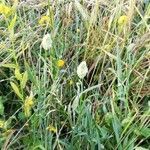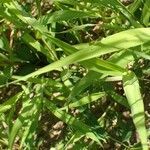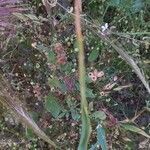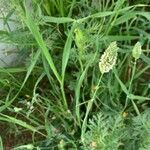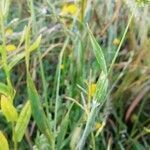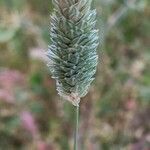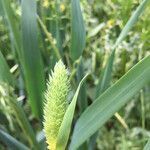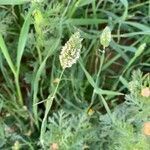Annual, caespitose. Culms (5–) 20–180 cm high, (3–) 4–6 (–10)-noded. Young shoots intravaginal. Leaves: basal sheaths often purple; ligule entire; blade 4–30 cm long, (2–) 3–13 mm wide. Panicles spike-like or capitate, 1–9 cm long, cylindrical to narrowly ovoid or lanceoloid, uninterrupted. Spikelets all bisexual. Glumes ±equal or subequal, 4–6.5 mm long, with conspicuous keel-wing on upper 2/3–3/4 tapering equally towards both base and apex or sometimes more gradually towards base than apex, usually erose to denticulate or irregularly 1–4-toothed toward apex, 3-nerved; midnerve scaberulous. Sterile lemmas markedly unequal; basal lemma reduced to a scale c. 0.2–0.3 mm long; second lemma mostly 1–1.5 (–1.8) mm long. Bisexual floret brown at maturity; lemma mostly 2.4–3.2 mm long, acute, becoming indurated, silky; palea with similar hairs to lemma on keel; anthers mostly 1–2 mm long; styles free to base.
Loosely tufted annual, (0.01-)0.20-1.00 m high; culms erect or geniculately ascending. Leaf blade 50-250 x 5-10 mm; ligule an unfringed membrane. Inflorescence a panicle, 10-60 x 10-15 mm. Spikelets 4.0-6.5 mm long, laterally compressed; glumes ± equal, much longer than spikelet, glabrous, winged, keel denticulate-undulate. Florets 2; lowest floret reduced, sterile, (0.2-0.3)0.5-1.3 mm long, sparsely pubescent; uppermost floret bisexual, 2.7-4.0 x 0.5-1.0 mm, hard, pilose; anther 1.5-2.0 mm long. Flowering time Sept.-Jan.
Loosely tufted annual (10-)200-1000 mm high; culms erect or geniculately ascending. Leaf blade 50-250 x 5-10 mm. Inflorescence 10-60 x 10-15 mm. Spikelet 4.0-6.5 mm long; glumes glabrous, pale green with dark green longitudinal stripes, winged, wing usually irregularly dentate or toothed, sometimes entire; sterile floret one, 0.5-1.3 mm long (occasionally 0.2-0.3 mm long), sparsely pubescent; fertile floret 2.7-4.0 x 0.5-1.0 mm, pilose; anther 1.5-2.0 mm long.
Annual, tufted. Culms 20–100 cm tall. Uppermost leaf sheaths not inflated; leaf blades 3–9 mm wide; ligule 4–6 mm. Panicle dense, ovate to oblong, 1–6 cm. Spikelets elliptic, 4.5–5.5 mm; glumes winged on upper part of keel, wing margin erose-denticulate; sterile lemma 1, ca. 1 mm, appressed-pilose; fertile lemma lanceolate-ovate, 2.7–4 mm, pubescent, becoming cartilaginous and shiny. Anthers 1.5–1.8 mm. 2n = 28.
Annual, loosely tufted (culms erect or geniculately ascending), up to 1 m high. Leaf blades 50-250 mm long, 5-10 mm wide. Spikelets 4-6 mm long. Panicle 20-50 mm long, 10-15 mm wide; glumes evenly winged, keel denticulate-undulate; female-fertile florets pilose; sterile floret one, 1.0-1.8 mm long (occasionally 0.2-0.3 mm long).
Annual; up to 1 m high; loosely tufted. Culms erect or geniculately ascending. Leaf blades 50-250 x 5-10 mm. Flowers: panicle compact; spike-like; 20-50 x 10-15 mm; spikelets 4-6 mm long; glumes evenly winged; keel denticulate-undulate; female-fertile florets pilose; sterile floret 1; (0.2-0.3)1.0-1.8 mm long.
Annual, up to 1 m tall, loosely tufted. Leaves linear; ligule an unfringed membrane. Inflorescence a spike-like, cylindrical panicle. Spikelets 4-6 mm long, awnless; glume keels narrowly but conspicuously winged; lowest floret sterile and minute; upper floret fertile.
Leaf-sheaths shorter than the internodes, tight at first, later loose or often somewhat inflated, striate, usually glabrous, smooth.
Leaf-laminae 5-10 x 0.3-1.2 cm., linear, tapering to a fine point, flaccid, glabrous, smooth but scaberulous along the margins.
Sterile floret usually 1 (the second: the first if present at all scale-like), c. 1-1.75 mm. long, subulate.
Panicles 1-6 cm. long, cylindrical to subglobose, rather dense and compact; rhachis and branches glabrous.
An annual grass. It grows 20-100 cm tall. The leaf blades are 3-9 mm wide. The flower panicles are dense.
Culms 20-100 cm. tall, 3-several-noded, rather weak, erect or geniculately ascending, striate, glabrous.
Spikelets 4-6.5 mm. long, obliquely broad-elliptic in lateral view, almost plano-convex.
Like P. canariensis but glume narrowly winged, spikelets 4-6 mm long, sterile floret 1.
Glumes subequal, 4-6.5 mm. long, with the wing erose-denticulate or sometimes entire.
Fertile lemma 2.7-4.0 mm. long, dorsally pubescent.
Ligule 2-7.5 mm. long, whitish.
Caryopsis 2.25-2.5 mm. long.
A loosely caespitose annual.
Anthers 1-1.5 mm. long.
